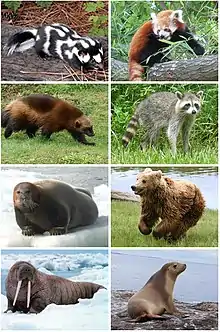Arctoidea
Arctoidea is a clade of mostly carnivorous mammals which include the extinct Hemicyonidae (dog-bears), and the extant Musteloidea (weasels, raccoons, skunks, red pandas), Pinnipedia (seals, sea lions), and Ursidae (bears), found in all continents from the Eocene, 46 million years ago, to the present.[2] The oldest group of the clade is the bears, as their CMAH gene is still intact. The gene became non-functional in the common ancestor of the Mustelida (the musteloids and pinnipeds).[3] Arctoids are caniforms, along with dogs (canids) and extinct bear dogs (Amphicyonidae). The earliest caniforms were superficially similar to martens, which are tree-dwelling mustelids. Together with feliforms, caniforms compose the order Carnivora; sometimes Arctoidea can be considered a separate suborder from Caniformia and a sister taxon to Feliformia.
| Arctoidea | |
|---|---|
 | |
| Scientific classification | |
| Domain: | Eukaryota |
| Kingdom: | Animalia |
| Phylum: | Chordata |
| Class: | Mammalia |
| Order: | Carnivora |
| Clade: | Canoidea |
| Infraorder: | Arctoidea Flower, 1869 |
| Subclades | |
| |
Systematics
Arctoidea was named by Flower (1869). It was reranked as the unranked clade Arctoidea by Hunt (2001), Hunt (2002) and Hunt (2002); it was reranked as the infraorder Arctoidea by Koretsky (2001), Zhai et al. (2003) and Labs Hochstein (2007). It was assigned to Carnivora by Flower (1883), Barnes (1987), Barnes (1988), Carroll (1988), Barnes (1989), Barnes (1992), Hunt (2001), Hunt (2002) and Hunt (2002); and to Caniformia by Tedford (1976), Bryant (1991), Wang and Tedford (1992), Tedford et al. (1994), Koretsky (2001), Zhai et al. (2003), Wang et al. (2005), Owen (2006), Peigné et al. (2006) and Labs Hochstein (2007).[4][5][6]
Phylogeny
The cladogram is based on molecular phylogeny of six genes in Flynn, 2005.[7]
| Caniformia |
| ||||||||||||||||||||||||||||||||||||||||||||||||||||||||||||||||||
References
- de Queiroz, K.; Cantino, P. D.; Gauthier, J. A. (2020). Phylonyms: A Companion to the PhyloCode. CRC Press. ISBN 978-0429821219.
- "Paleobiology Database: Arctoidea Basic info".
- Ng, Preston S.K.; Böhm, Raphael; Hartley-Tassell, Lauren E.; Steen, Jason A.; Wang, Hui; Lukowski, Samuel W.; Hawthorne, Paula L.; Trezise, Ann E.O.; Coloe, Peter J.; Grimmond, Sean M.; Haselhorst, Thomas; von Itzstein, Mark; Paton, Adrienne W.; Paton, James C.; Jennings, Michael P. (2014). "Ferrets exclusively synthesize Neu5Ac and express naturally humanized influenza a virus receptors". Nature Communications. 5: 5750. doi:10.1038/ncomms6750. PMC 4351649. PMID 25517696.
- R. M. Hunt. 2001. "Small Oligocene amphicyonids from North America (Paradaphoenus, Mammalia, Carnivora)". American Museum Novitates 3331:1–20
- I. Koretsky. 2001. "Morphology and systematics of Miocene Phocinae (Mammalia: Carnivora) from Paratethys and the North Atlantic region". Geologica Hungarica Series Palaeontologica 54:1–109
- J. Labs Hochstein. 2007. "A new species of Zodiolestes (Mammalia, Mustelidae) from the early Miocene of Florida". Journal of Vertebrate Paleontology 27(2):532–534
- Flynn, J. J.; Finarelli, J. A.; Zehr, S.; Hsu, J.; Nedbal, M. A. (2005). "Molecular phylogeny of the Carnivora (Mammalia): Assessing the impact of increased sampling on resolving enigmatic relationships". Systematic Biology. 54 (2): 317–37. doi:10.1080/10635150590923326. PMID 16012099.